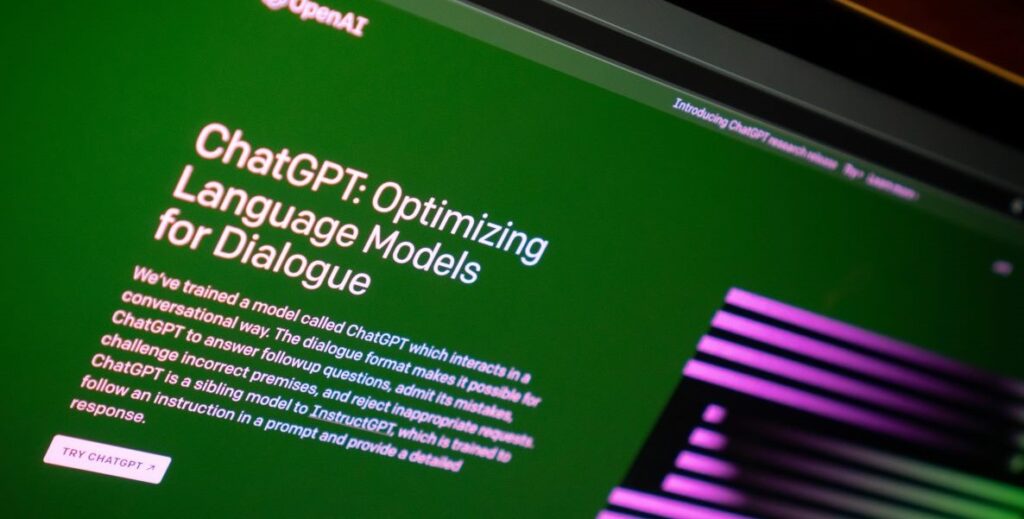A Writer’s Resource, my co-authored college writing textbook, is about to be published in its seventh edition. In the midst of putting finishing touches on the Instructor’s Manual, we decided to stop the presses so we could include guidance on the classroom use of ChatGPT, the artificial intelligence bot, created by OpenAI, ready and able to write five-paragraph themes on just about anything.
I am not in favor of banning ChatGPT. In fact, for decades, I’ve been trying to ban the five-paragraph theme from high school and college instruction. Why? The five-paragraph essay is useless. In the world beyond the classroom, no one writes five-paragraph essays or reads them. Meaningful writing must have purpose, voice, and intended readers.
To gain first-hand knowledge of what ChatGPT can do, I signed up at the website and tested a typical February classroom assignment: Write an essay arguing that the State of the Union address is a significant moment in a U.S. presidency. In seconds, ChatGPT generated a five-paragraph essay with correctly structured sentences and basic information on the purpose of the State of the Union address. I then asked ChatGPT to give me historical examples of important State of the Union speeches and got Franklin Roosevelt’s “Four Freedoms,” Lyndon Johnson’s “Great Society,” and Ronald Reagan’s “axis of evil.” I could have improved the original essay with references to those examples.
Professor Munemo sums up the ChatGPT issue with a warning, “In a world where students are taught to write like robots, it’s no surprise that robots can write for them.”
Throughout this exploration, I must confess I felt like a college kid surreptitiously reading CliffsNotes in the bookstore. (I never did that!) But the aura of shame about not doing my own work was there.
Artificial intelligence has been with us for a while and many tech companies, including OpenAI, are working now to make writing bots more and more effective. They can already do a lot. Nick Kindelsperger, food critic for the Chicago Tribune, tested ChatGPT to see if it could write restaurant reviews. He found that ChatGPT could indeed write a general review of Alinea, a three-Michelin-starred Chicago restaurant. But it could not comment on specific menu items. What it could do was to write a review, if asked, in the style of William Shakespeare:
“Ah, sweet Alinea, how doth thy flavors please
Thy dishes, a symphony of taste and ease …”
If ChatGPT can do so much, is writing instruction dead?
The answer to that question is an emphatic NO. The existence and continued improvement of artificial intelligence make it necessary for schools, colleges and universities to ensure that their writing programs do what decades of research have indicated excellent writing programs should accomplish: Connect writing with thinking, enable students to find their own voice, and empower writers to achieve their own goals through written communication.
Professional organizations are issuing guidelines. The Association of Writing Across the Curriculum (AWAC) has developed a “Statement on Artificial Intelligence Writing Tools in Writing Across the Curriculum Settings.” AWAC states, “Writing to learn is an intellectual activity that is crucial to the cognitive and social development of learners and writers. This vital activity cannot be replaced by AI language generators.”
What must happen is a rethinking of writing instruction, grade school through grad school, to focus on what Julia McKenzie Munemo of Williams College calls in a piece in Inside Higher Ed the true goal of writing, “to clarify, understand and experience our own thinking.” Professor Munemo sums up the ChatGPT issue with a warning, “In a world where students are taught to write like robots, it’s no surprise that robots can write for them.”
The world of writing instruction must be populated by thinkers, not automatons. As a scholar and as a founder of writing across the curriculum, I have written often about the significant improvements in writing instruction over the past 40 years to connect writing and thinking and to prepare writers who will achieve important goals.
As I wrote in a previous Citizen column: “Anything produced by artificial intelligence will lack the imagination and critical thinking that makes a difference in the world. But how many understand the true essentials of writing — not commas and semicolons (although control of grammar and punctuation is essential for public communication) — but writing as thought made visible.”
ChatGPT will produce writing that is technically correct but lacking in a personal, human element.
What Educators Can Do About ChatGPT
- Use ChatGPT openly in the classroom. Demonstrate what artificial intelligence can do and what it can’t do.
- Develop assignments that engage students in the process of discovery, drafting, and revision.
- Revise rules on plagiarism to require students to openly acknowledge any help from AI.
- Do not ban the use of AI. It’s here to stay and getting “smarter” every day.
What the General Public Can Do
- As parents, make sure your kids — from birth — think of themselves as readers and writers. Before they can form letters, encourage drawing. When our son and daughter were toddlers, we posted a marketing list on the refrigerator and said that we would buy any grocery item they could communicate to us in writing.
- Support enlightened writing instruction in schools and colleges. Vote for school board members who understand its importance.
- Donate to colleges and universities that teach writing across the curriculum.
- Readers who would like to take a course in writing to make a difference can find a self-paced course offered for $11 online by the Miami University of Ohio Writing Institute.
ChatGPT did not write this article.
Elaine Maimon, Ph.D., is the author of Leading Academic Change: Vision, Strategy, Transformation. Her co-authored book, Writing In The Arts and Sciences, has been designated as a landmark text. She is a Distinguished Fellow of the Association for Writing Across the Curriculum. Follow @epmaimon on Twitter.

